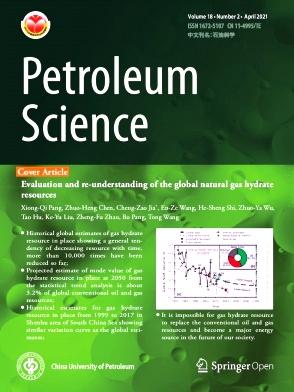高粘度重油化学成分的表征:宏观特性以及利用高分辨率质谱对分子成分进行半定量分析
IF 6
1区 工程技术
Q2 ENERGY & FUELS
引用次数: 0
摘要
重油是当前石油开采的重要资源,而重油的化学成分信息对于揭示其致粘机理、解决实际开采问题至关重要。本研究采用高温气相色谱法和电喷雾离子源高分辨质谱法揭示了中国西部、中部和东部典型重油的化学成分。结果表明,这些重油的体积特性差异显著,初始沸点均高于 200 °C。利用预处理和 ESI 高分辨率质谱仪,对重油中饱和碳氢化合物、芳香烃、酸性氧化合物、硫化合物、碱性氮化合物和中性氮化合物的分子组成进行了分析。最终,通过整合元素含量,实现了对重油分子组成的半定量分析。胜利-J8 重油和常规胜利原油的半定量分析结果表明,胜利-J8 重油缺乏烷烃和低分子量芳香烃,因此粘度较高。此外,根据分子组成的半定量分析,确定了不同重油的特征分子组。重油分子组成的半定量分析可为建立重油致粘机理的理论模型和设计重油开采的降粘剂提供有价值的参考数据。本文章由计算机程序翻译,如有差异,请以英文原文为准。
Characterization of chemical composition of high viscosity heavy oils: Macroscopic properties, and semi-quantitative analysis of molecular composition using high-resolution mass spectrometry
Heavy oil is an important resource in current petroleum exploitation, and the chemical composition information of heavy oil is crucial for revealing its viscosity-inducing mechanism and solving practical exploitation issues. In this study, the techniques of high-temperature gas chromatography and high-resolution mass spectrometry equipped with an electrospray ionization source were applied to reveal the chemical composition of typical heavy oils from western, central, and eastern China. The results indicate that these heavy oils display significant variations in their bulk properties, with initial boiling points all above 200 °C. Utilizing pre-treatment and ESI high-resolution mass spectrometry, an analysis of the molecular composition of saturated hydrocarbons, aromatic hydrocarbons, acidic oxygen compounds, sulfur compounds, basic nitrogen compounds, and neutral nitrogen compounds within the heavy oil was conducted. Ultimately, a semi-quantitative analysis of the molecular composition of the heavy oil was achieved by integrating the elemental content. The semi-quantitative analysis results of Shengli-J8 heavy oil and a conventional Shengli crude oil show that Shengli-J8 heavy oil lacks alkanes and low molecular weight aromatic hydrocarbons, which contributes to its high viscosity. Additionally, characteristic molecular sets for different heavy oils were identified based on the semi-quantitative analysis of molecular composition. The semi-quantitative analysis of molecular composition in heavy oils may provide valuable reference data for establishing theoretical models on the viscosity-inducing mechanism in heavy oils and designing viscosity-reducing agents for heavy oil exploitation.
求助全文
通过发布文献求助,成功后即可免费获取论文全文。
去求助
来源期刊

Petroleum Science
地学-地球化学与地球物理
CiteScore
7.70
自引率
16.10%
发文量
311
审稿时长
63 days
期刊介绍:
Petroleum Science is the only English journal in China on petroleum science and technology that is intended for professionals engaged in petroleum science research and technical applications all over the world, as well as the managerial personnel of oil companies. It covers petroleum geology, petroleum geophysics, petroleum engineering, petrochemistry & chemical engineering, petroleum mechanics, and economic management. It aims to introduce the latest results in oil industry research in China, promote cooperation in petroleum science research between China and the rest of the world, and build a bridge for scientific communication between China and the world.
 求助内容:
求助内容: 应助结果提醒方式:
应助结果提醒方式:


